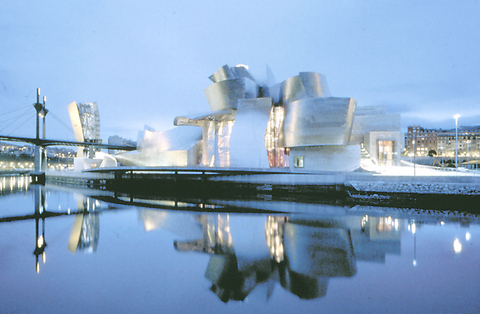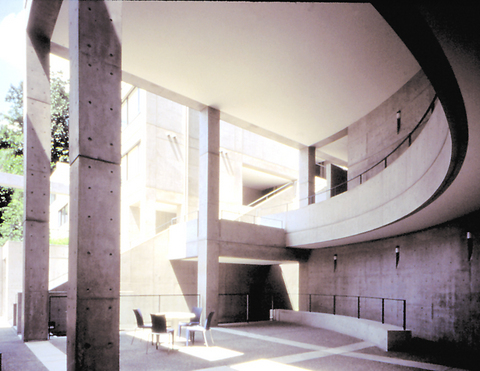The Taipei Fine Arts Museum is the hot cultural spot to visit these days as the place is overflowing with exciting chatty crowds. However, if you get too impatient waiting in the long queue to view the Vivienne Westwood fashion retrospective, then sneak right past to the third floor to see two provocative, yet disparate exhibitions.
The Art of Architecture: Works by Laureates of the Pritzker Architecture Prize was jointly organized by the museum and the Taipei Architects Association. Rather than being visually imaginative, the straightforward display is didactic and orderly in presenting chronological information on the winners from 1979 to today.
The Pritzker Architecture Prize is often referred to as the Nobel prize of architecture as it is the highest award given in its field with laureates receiving a US$100,000 grant, a formal certificate and a bronze medallion. The list of Laureates is impressive and reads like a Who's Who of the world's leading architects: Luis Barragon, Norman Foster, Frank Gehry, Oscar Niemeyer who built Brasilia, Richard Meier, I.M. Pei, Robert Venturi, Tadao Ando. Surprisingly, in its 26-year history, the prize has only been awarded to one woman -- Zaha Hadid, the architect who was slated to design the Taichung branch of the Guggenheim.

PHOTOS COURTESY OF TFAM
The first Pritzker recipient in 1979 was Philip Johnson and images of his famed glass house are on view. Equal weight is given to all the laureates' work at the exhibition. Large folding partitions contain photo blowups of world-renowned buil-dings, while small models are interspersed throughout the exhibition space. In addition, there is a highly informative reading area that contains architecture books installed on waist-level platforms. Unfortunately, there is no place to sit as this is part of the passageway, making it uncomfortable to linger and leisurely browse through the chained-up coffee table books. To the exhibition's detriment, the presentation is hard edged and not very comfy or user-friendly, which has become a recent trend in museum-based art shows.
The other exhibition is entitled The Movement of the Bamboo Stool -- A Memorial Exhibition of Lii Jiin-shiow (
The bamboo stool symbolizes the humbleness and traditional character of her life. She wasn't a diva trying to loom large on the art stage; she chose to live a modest ordinary life, raising a child, while continuing to paint and draw. Her sketches were personal reflections of an unassuming life.

Lii constantly painted and sketched her environment and was an adept draftsperson displaying great sensitivity to line and form. The exhibition is in six sections that chronologically mark her artistic journey. Before she moved to Paris she embraced Impressionist and Cubist styles.
While in Paris (1983 to 1986), Lii explored painting on transparent surfaces. Upon returning to Chiayi and Tainan she painted and drew trees as a metaphor for the vast universe.
Her later works were influenced by her Taiwanese calli-graphy teachers and her traditional French art education; yet, she painted what was ultimately the most important subject to her -- her family.
Exhibition details:
What: The Art of Architecture (to Dec. 4); and The Movement of the Bamboo Stool
Where: Taipei Fine Arts Museum,181, Zhongshan North Road, Sec 3, Taipei
(
Telephone: (02) 2595 7656
When: Until Dec. 4 and Nov. 27 respectively

That US assistance was a model for Taiwan’s spectacular development success was early recognized by policymakers and analysts. In a report to the US Congress for the fiscal year 1962, former President John F. Kennedy noted Taiwan’s “rapid economic growth,” was “producing a substantial net gain in living.” Kennedy had a stake in Taiwan’s achievements and the US’ official development assistance (ODA) in general: In September 1961, his entreaty to make the 1960s a “decade of development,” and an accompanying proposal for dedicated legislation to this end, had been formalized by congressional passage of the Foreign Assistance Act. Two

Despite the intense sunshine, we were hardly breaking a sweat as we cruised along the flat, dedicated bike lane, well protected from the heat by a canopy of trees. The electric assist on the bikes likely made a difference, too. Far removed from the bustle and noise of the Taichung traffic, we admired the serene rural scenery, making our way over rivers, alongside rice paddies and through pear orchards. Our route for the day covered two bike paths that connect in Fengyuan District (豐原) and are best done together. The Hou-Feng Bike Path (后豐鐵馬道) runs southward from Houli District (后里) while the

March 31 to April 6 On May 13, 1950, National Taiwan University Hospital otolaryngologist Su You-peng (蘇友鵬) was summoned to the director’s office. He thought someone had complained about him practicing the violin at night, but when he entered the room, he knew something was terribly wrong. He saw several burly men who appeared to be government secret agents, and three other resident doctors: internist Hsu Chiang (許強), dermatologist Hu Pao-chen (胡寶珍) and ophthalmologist Hu Hsin-lin (胡鑫麟). They were handcuffed, herded onto two jeeps and taken to the Secrecy Bureau (保密局) for questioning. Su was still in his doctor’s robes at

Mirror mirror on the wall, what’s the fairest Disney live-action remake of them all? Wait, mirror. Hold on a second. Maybe choosing from the likes of Alice in Wonderland (2010), Mulan (2020) and The Lion King (2019) isn’t such a good idea. Mirror, on second thought, what’s on Netflix? Even the most devoted fans would have to acknowledge that these have not been the most illustrious illustrations of Disney magic. At their best (Pete’s Dragon? Cinderella?) they breathe life into old classics that could use a little updating. At their worst, well, blue Will Smith. Given the rapacious rate of remakes in modern